News and Site Updates Archive 2009/11/30
Is it your reputation that's bothering you? But look at how soon we're all forgotten - that swallows it all, the emptiness of those applauding hands.
~ Marcus Aurelius
30 Nov '09 -
 |
Why do women still end up doing more housework than men? Why are so many instances of domestic violence triggered by apparent or perceived failures in the preparation and
ready provision of food? Did human monogamy evolve as a protection racket in which males ensured that their vulnerable stove-tending spouses didn’t get their food
stolen? Archaeologists have found earth ovens which are more than 250,000 years old.
Is learning to cook our food what finally made us
human? |
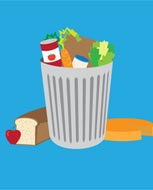 |
New York City alone has an annual surplus of about 50 million pounds of food. Ten years ago, the United States Department of Agriculture estimated that more than 96
billion pounds of edible food went to waste. Some estimates say the US throws away about half of the food it produces. There’s probably enough wasted food in the US and
Europe to feed the world’s hungry 3 times over. In just one year the US may produce enough food waste to feed all of Europe. Food waste contributes to environmental
degradation, global warming, soil erosion, habitat destruction, and starvation.
Waste is a moral crisis. |
 |
Infectious diseases spread through food or beverages are common, distressing, and sometimes life-threatening for millions of people worldwide;
76 million people in the US alone suffer from food-borne illnesses each year, accounting for
325,000 hospitalisations and more than 5,000 deaths. The yearly cost is $5 to $6 billion in direct medical expenses and lost productivity. More than 250
food-borne diseases are known, caused by bacteria, viruses, or parasites. Natural and manufactured chemicals in food also make people ill. Some toxins come from
germs, others from the human body’s own reactions. Now, public health, agriculture, and environmental officials have an additional concern - bioterrorism. The
scary truth: staples like burgers, seafood, chicken, egg salad, and even watermelon can make your family sick if you don't wash, handle, cook, and store them properly. Most
food-borne illnesses are preventable. Norovirus and salmonella were leading causes in 2006 (the latest year for which statistics are available). A regulatory
structure is needed to find sources and design prevention programmes.
Most illnesses, hospitalisations, and deaths caused by food are not recorded as
such. |
 |
Watermelon (Citrullus lanatus family Cucurbitaceae) is both the fruit and plant of a vine-like
herb originally from southern Africa, where it grows wild. One of the most common types of melon, the fruit, known by botanists as a pepo (berry) has a thick rind
and fleshy centre with smooth exterior rind (green, yellow, and sometimes almost white) and juicy, sweet interior flesh (usually pink, but can be orange, yellow, red, white - or
green if not ripe). There are more than 1,200 varieties ranging in size from less than 1 to more than 200 pounds. Many seeds were found in the tomb of Pharaoh
Tutankhamen. By 1000AD, watermelons were cultivated in China (today the world's single largest producer). In Japan, farmers of the Zentsuji region grow cubic watermelons in glass
boxes which let them naturally assume the shape of their receptacle (square shapes make watermelons easier to stack and store but double prices). Pyramid shapes have also been
developed. The current world record watermelon weighed 262 pounds (119 kg). Oklahoma declared watermelon to be the official state vegetable (controversial, as it's a fruit).
Citrulline in watermelon (especially the rind) stimulates nitric oxide, which relaxes and expands blood vessels (much like
erectile-dysfunction drug Viagra) and it may increase libido. |
 |
A 53-year-old businesswoman weighing 22 stone (139 kg) says she was sitting in an almost empty train car in early evening when she was kicked, punched and shouted at for taking
up two seats. "Normal rules of behaviour, respect, and common courtesy don't apply to us," she said. 60% of British adults are overweight / 26% are obese; 28% of
children are overweight / 15% are obese. Obesity surgery on NHS rose 40% in the past year. 60% of men, 50% of women and 25% of children will be obese by 2050 if trends
continue. The rise of "fattism" is met with a backlash from those affected, triggering a nascent rights movement. Why are many so intolerant of fat people? Discrimination
on other grounds is frowned upon but weight is different. Often people assume that the overweight have no self-control. Everyone wants to be slim, but physical perfection is
difficult to hold on to and we fear losing control. Some diet their whole lives and are utterly miserable. Do they disassociate themselves from what they fear most: getting
fat? We aren't all meant to be thin. Can dislike of fatties be controlled? In some cases, maybe not.
Every overweight person is the person we must not be. |

| Intermittent access to foods rich in fat and sugar induces changes in the brain comparable to those observed in drug dependence. This may explain how abstinence from
these foods contributes to relapse eating among dieters as well as related eating disorders. Forms of obesity and eating disorders can be defined as chronic conditions
with alternating periods of abstinence and relapse that continue despite negative consequences. Although the positive reinforcing properties of palatable foods are well
known, less attention has been given to foods used to relieve negative emotional states. Researchers gave rats standard rat chow for 5 days, followed by a highly
palatable, high-sugar, chocolate-flavoured chow for 2 days. When rats were again fed standard chow, they showed less motivation to obtain it, refused it although it was
previously acceptable, and exhibited anxiety. But when they resumed eating the tasty food, they overate - and their behaviour returned to normal.
The lesson here isn't "never diet", it's "never gain weight in the first
place". |
 |
Activity in the brain is stimulated not only by food itself, but also by cues suggesting that food is nearby. First, we learn through experience that a cue is linked to a
specific food. Once this happens, the signal that predicts the food, rather than the food itself, generates the dopamine response. This signal then becomes the trigger of
desire - a "conditioned stimulus." The cues arouse us and this conditioning can happen quickly. In one study, people were given a high-sugar, high-fat snack for 5
consecutive mornings. For days afterwards, they craved something sweet at about that same time each morning, even though they hadn't previously snacked then; desire had already
taken hold. "Incentive salience" is the desire, activated by cues, for something that predicts reward - a learned association (it's the wanting, not the liking, that drives
us). Visual cues include not only the sight of food, but the sight of a restaurant where we once ate that food, the street corner we pass en route, or a billboard advertising
that restaurant. Sounds and smells or time of day and location can assume the same stimulating power. So, too, can people and moods, both positive and negative, once
associated with a stimulus: the aroma of cherry pie can evoke your grandmother's home-cooked meals, creating a dopamine-driven desire.
Perhaps only a subset of the population has heightened incentive salience and perhaps rewarding foods trigger
overeating primarily in that group. |
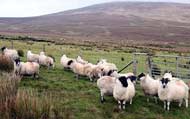 |
At the end of World War II, it took the British working man roughly 6 hours of daily labour to feed a family of 4; today, it's 2 hours. A revolution in farming began in the US
during the '30s when breeders found that crossing different strains of maize improved output. Plant science transformed economic and physical landscapes across the world: 50
years ago many hill farmers’ fields were sparse, their thin grass fodder for sheep and cattle. The animals are still there, but for them eating is easier - fields are greener
and lambs fatter thanks to science. Their new life – like ours – comes from sugar. Easily digested and irresistible to beasts and men,
sugar is the drug of the 21st
century. Glucose syrup from maize is the raw material that makes junk food, from fizzy drinks to chicken thighs. In the States (trash-food capital of the world) most
cattle never see grass but are fed on maize or sugar-supplemented pellets in giant feed lots. Even the new grasses contain sugar. Much energy in ordinary grass is locked
away as cellulose, but new strains make more sugar within the cells. Intestinal biota then soak it up, using it to break up more grass protein to feed their hosts. Lambs
grow 20% faster and cows make more milk on the new crops (and less nitrogen-rich manure pours out to poison fields and pollute rivers). |
 |
Drink your milk: These koi carp goldfish have been brought up on a diet of
powdered milk by their owner in an effort to keep them strong. He owns an aquarium in eastern China and says that koi that are the right colour can end up selling for more than
£10,000. He and his colleagues find milk makes the fish strong and active. "It took my fish a little while to get used to it but now they love the new feed. As soon
as they see me coming over with the bottle they fight to be the first to suck. I don't use regular food anymore - I just give them milk."
They don't like sugar? Oh, they aren't being raised to be eaten, but to be healthy? |
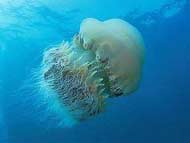 |
A blood-orange blob the size of a small refrigerator emerges from the dark waters, its venomous tentacles trapped in a fishing net. Within minutes, hundreds more are hauled up,
pulsating masses weighing up to 200 kilograms each, crowding out the catch of mackerel and sea bass. These marine invaders put livelihoods at risk. The venom of the
Nomura, world's largest jellyfish (a creature up to 2 metres in diameter) can ruin a whole day's catch by stinging the fish ensnared with them, tainting or killing them. Once
considered a rarity occurring every 40 years, they now swarm almost every year along several thousand kilometres of Japanese coast and far beyond. The gelatinous seaborne
creatures decimate fishing industries in the Bering and Black seas, force the shutdown of seaside power and desalination plants in Japan, the Middle East and Africa, and scare
beachgoers worldwide. Increasingly polluted waters boost growth of microscopic plankton that "jellies" eat, while overfishing eliminates any predators they may have and reduces
competition for plankton.
They show our oceans have become stressed and unhealthy. |
 |
Extraordinary chickens: this is a
Wyandotte white cockerel. These are docile birds and their attractive curvy shape, generally good disposition and many attractive varieties make them a good choice for fanciers
as well as farmers. (Is it just me? It looks like he wears his brain on the outside of his skull rather than on the inside.)
(And if you really like odd chickens, I have 3 pages worth of photos starting here). |
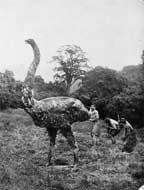 |
The moa is no moa. |
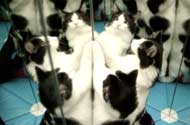 |
Sextuplets? |
 |
Blue-eyed albino snake (via PeyoteCoyote). In trying to find out more about this photo, I viewed an amazing array
of albino animals.
If you want to see them,
you can look them up for yourself. |
 |
Salvador Dalí exits a Paris Metro station led by his trusty giant anteater in 1969. His obsession for anteaters supposedly came about as a reaction to the tyrannical André Breton, who was known
as le tamanoir ("the anteater"). "Oddly enough, when I showed this picture to the director he said, 'It was a fun day." At first, I didn't quite understand, but then upon closer
inspection I realised that the director is, in fact, standing in the far right of the photo gazing down at the anteater. He lamented that Dalí had the photographer re-shoot the picture what
seemed like 'countless' times until he and the anteater were perfectly composed. The director later added with a smile, 'The only difference between Dalí and a crazy man is that Dalí had better press photos.'"
What I'd like to know is if Dalí kept his "pet" after the photos were taken. |
 |
Between You and I, 2006, a solid light installation at Peer/The Round Chapel, London by artist Anthony McCall, who states: "...the speed of disclosure, for me, has to be slow.
And that has to do with leaving the spectator with the freedom to move without feeling that they’ll miss something.
"So the form of disclosure says cinematic but the speed of disclosure says, 'This is sculptural space'." |
 |
Lone Horse by photographer Jared May, 1996. Taken in Flint Hills in northeast Kansas, USA. |
 |
Sunset/Dandelion, also by Jared May, April 2006. Taken in Riley, Kansas.
How does May manage to make Kansas look so good? (Perhaps he likes it?) |
 |
The Andromeda Strain by photographer Cassander Schattenkerk
who writes: "Using low-budget special effects and lighting
I staged natural phenomena and imagery... I often choose material that has a perishable or unpredictable quality, like foam or spaghetti. No Photoshop is used to achieve
the effects. The artificial and the real, and the different sources the image is based on, should be present simultaneously." |
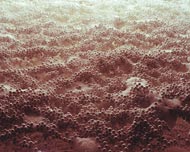 |
This is another odd photo from Cassander Schattenkerk (via the New Shelton Wet/Dry). |
 |
Mouth of the Flower by Octavio Ocampo.
I don't like the title (I'd probably have called it Petal) and I don't really like some of his work. Still, I thought this was fairly well done. |
 |
Mark Oliver Everett is the son of physicist Hugh Everett III, originator of the many-worlds
interpretation of quantum theory and of the use of Lagrange multipliers for general engineering optimisations. Hugh was a distant father and an alcoholic who died of a heart
attack in bed on 19 July 1982, a teenage Everett finding his body. Everett's sister, long troubled by schizophrenia, committed suicide in 1996, and in 1998 his mother died of
lung cancer. (Later, Everett's cousin, Jennifer Lewis, was a flight attendant on the plane that struck The Pentagon during the 11 September 2001 attacks.) Following these tragedies,
Everett and the his band, the Eels, released Electro-Shock Blues, whose sound alternates between furious indefatigableness, black humour, and strikingly authentic desperation. It gained
almost unanimous critical praise.
Everett's music has been featured in a number of films, including American Beauty, Holes, Shrek, Shrek 2, Shrek The Third, Hellboy II: The Golden Army, and
Hot Fuzz; as well, the Eels supplied almost all the music in Yes Man. |
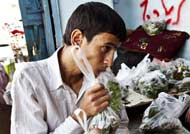 |
More than half of Yemen's scarce water feeds an addiction, a crisis that may
prove deadly. At its root is a population that quadrupled in 50 years (now at 24 million). Even as drought kills crops, farmers turn increasingly to a thirsty plant
called qat, whose leaves are chewed daily by most Yemeni men (and some women) for a mild narcotic effect. Farmers have little choice if they wish to make a profit. Meanwhile, wells
run dry; deep, ominous cracks 100s of yards long open in parched earth. Water scarcity afflicts much of the Middle East but Yemen’s poverty and lawlessness make it worse. The government
supplies water every 45 days in some urban areas but there is little public water. Water's price has quadrupled in 4 years, so people drill illegally into rapidly receding aquifers. Yemen
lacks money to invest in desalination plants; even wastewater treatment is difficult as clerics declare reusing wastewater violates Islamic principles. In rural areas, people drink from cloudy,
stagnant cisterns where animals drink; the poorest gather runoff from privately owned wells; the wealthy pay the equivalent of $10 for a 3,000 litre-truckload. Agriculture began failing in the
'60s after cheap foreign grain flooded Yemen. Qat replaced food crops; motorised drills allow water to be pumped from underground aquifers much faster than natural processes replace
it. The water table drops an astonishing 60 feet a year causing land subsidence. Sinkholes grow. Despite its destructive effects, the Yemeni government supports qat. But
powerful growers known as the "qat mafia" shoot down planes bringing cheaper qat from abroad. |
 |
Australia expects seas to rise by 80 centimetres (31 inches). Authorities are divided over whether to retreat from the rising water or defend the coastline instead. Nearly 80% of
Australians live in coastal areas. New laws may ban further development in these coastal regions and authorities may
even consider prohibiting continued occupation of this land due to sea hazard. Aus$150 billion worth of property is at risk.
Of course, that's assuming that the future has been adequately predicted in that regard. |
 |
Under the worst-case scenario predicted by the International Panel on Climate Change, the global surface temperature of Earth could increase by as much as 5˚ Celsius by the end of
this century. Such a scenario would lead to up to a half-metre rise in sea level, flooding coastal regions including many of the world’s major cities. Meanwhile, nearly
1/3 of the planet could become desert and more than 1/2 would experience drought. The salinisation of much of Earth’s groundwater supply will make this worse. At even a 3.5˚C
increase, the potential for geopolitical conflicts over dwindling resources is mind-boggling. Global carbon levels are at 380 parts per million compared to 280 before the
Industrial Revolution. Most scientists conclude catastrophic effects occur once those levels pass 450.
If 800 - 1000 parts per million are reached (as worst-case scenarios
predict), it’s anybody’s guess. |
 |
On the Other Hand: It once took Europe only months to be engulfed by an
ice age. Around 12,800 years ago, the northern hemisphere was hit by the Younger Dryas mini ice age, or "Big Freeze," triggered by a slowed Gulf Stream and leading to the decline of
Clovis culture in North America; it lasted around 1,300 years. At its start, temperatures plummeted within months (a year at most) - significantly faster than previously believed and climate
recovery took 200 years. Sudden climate switches are not unusual in geological records. The Younger Dryas happened when a glacial lake covering most of northwest Canada burst its banks and
poured into the North Atlantic and Arctic Oceans. The huge flood diluted salinity-driven North Atlantic Ocean mega-currents and stalled the Gulf Stream. A similar thing happened again 8,200
years ago and the Northern hemisphere went through another cold spell. But the balance between the airborne and the absorbed fraction of
CO2 has stayed approximately constant since 1850, despite emissions having risen from 2 billion tons a year in 1850 to 35 billion tons now. Do terrestrial ecosystems and oceans
have a much greater capacity to absorb CO2 than previously expected? This conclusion rests solely on measurements and statistical data, including historical records extracted from
Antarctic ice, not computations with complex climate models. Emissions from deforestation might be overestimated by as much as 75%.
And this means - what? |
 |
There are currently more than 23,000 nuclear weapons in the world of which 8,000 are operational and 2,000 are on high alert and ready to launch on short notice. The
Bulletin of the Atomic Scientists created the famous "Doomsday Clock" in 1947 to convey how close humanity is to "catastrophic destruction." The clock reached its
high-point - 2 minutes to midnight - after the first hydrogen bomb tests in 1953. The BAS moved the clock back to 17 minutes after the end of the Cold War but it has
been steadily ticking back toward midnight since.
With rogue states such as North Korea developing nuclear weapons and tensions increasing between nuclear-armed India and Pakistan, it currently stands at 5 minutes to midnight. |
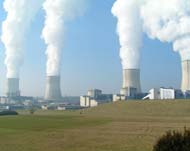 |
The world is about to enter a period of unprecedented investment in nuclear power. The combined threats of climate change, energy security, and fears over high prices and dwindling reserves of oil
force governments towards the nuclear option. The perception is that nuclear power is a carbon-free technology, that it breaks our reliance on oil, and that it gives governments control over
their own energy supply. That looks dangerously overoptimistic. Perhaps the most worrying problem is the
misconception that uranium is plentiful. The world's nuclear plants today eat through some 65,000 tons of uranium each year. Of this, the mining industry supplies about 40,000
tons. The rest comes from secondary sources such as civilian and military stockpiles, reprocessed fuel and re-enriched uranium. But without access to the military stocks, the civilian
western uranium stocks will be exhausted by 2013.
It's not clear how the shortfall can be made up since nobody seems to know where the mining industry can look for more. |
 |
Habog - an interim store for high-level radioactive waste - features a
bright orange exterior and prominently displays Albert Einstein's equation, E=mc2 and Max Planck's E=hv. Designed to last for up to 300 years, it contains the
waste resulting from reprocessing all nuclear fuel from the Netherlands' nuclear power stations after electricity generation. The waste inside Habog is planned to
remain there for 100 years, during which time its radioactivity will decrease through decay. This process is symbolised by the colour of the building's exterior, which is to be
repainted every 20 years in lighter and lighter shades of orange until reaching white. |
 |
This is one of a sequence of photos shot on special black and white film at about
10,600,000 frames per second during the 1945 Trinity Test when Los Alamos fired the first atomic bomb. These are Harold Edgerton images. (Edgerton was an MIT
professor who perfected stroboscopic photography.) The sequence was triggered from the primary firing mechanism. The camera had 3,500 feet of pre-tensioned 35 millimetre
film on a huge spool and the shots are about 3 or 5 frames apart (they never could really tell) at the climax speed of the camera when the test weapon went off. The camera
exploded after these photos because it was going so fast, but it shot 2/3 of a mile of film frames before it disintegrated. Edgerton had made a special heat and blast
resistant magnesium-alloy housing for the film to spin off and eject laterally when the camera exploded, so they could recover the exposed film after a predicted camera failure. |
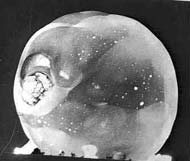 |
Edward Teller saw the Trident III missiles and said they were the worst weapons to keep on hair-trigger alert, because if they were ever launched on a full firing mission (which they're designed to do)
they'd destroy at least 200 million people in less than 15 minutes. Then, every Russian SS-18, SS-20, and TOPOL SS-22 missile will fly automatically, invoking our MILSTAR II system to authorise
and auto-fire all our remaining ground-based missiles to impact on Russia and China. As of June 2004, the US had 550 ready strategic ballistic nuclear missiles in a stable of ground silos
delivering 1,700 MIRV individual nuclear warheads, 24 SLBM boomer submarines with 18 MIRV TRIDENT III missiles (12 in each cone for independent delivery). That makes 5,184 individual 300-kiloton
nuclear warheads from SSBN submarines and there are 245 nuclear cruise missiles ready to go on B1B and B2 Spirit bombers. That's 7,200 ready-to-launch nuclear weapons. Russians have about
9,000. And the Chinese are ponying up about 100, possibly 200. That is WAY too many thermonuclear hydrogen weapons criss-crossing the globe for anyone to
survive. Teller was the first to see these frames and he was ecstatic. But moments later
he was depressed, realising the US was going to drop these weapons on Japan. He forever regretted his role in development of these infernal death machines but stuck with it into the post-World
War II era, helping make even larger hydrogen fusion weapons. |
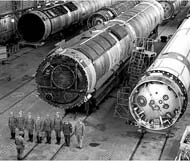 |
In the past 20 years, nuclear disarmament has become an integral part of the
electricity industry, little known to most Americans. Salvaged bomb material now generates about 10% of electricity in the US — by comparison, hydropower generates about 6%
and solar, biomass, wind and geothermal together account for 3%. Utilities have been loath to publicize the Russian bomb supply line for fear of spooking consumers: the fuel
from missiles that may have once been aimed at your home may now be lighting it. But at times, recycled Soviet bomb cores have made up the majority of the American market for
low-enriched uranium fuel. Today, former bomb material from Russia accounts for 45% of the fuel in American nuclear reactors, while another 5% comes from American bombs. |
 |
People constantly make complex decisions, from the more mundane — which restaurant to go to for dinner or which movie to go see — to the more profound — whether or not to have kids. The brain
chemical dopamine plays an important role by influencing our expectations of the pleasure associated with outcomes. When we imagine future events, activity in a dopamine-laden part of the brain tracks estimates of the expected pleasure to be
derived from those events. Manipulating dopamine levels in subjects' brains alters their expectations, and with them their choices. Researchers first asked people to rate their
expectation of happiness if they were to vacation at each of 80 destinations, from Thailand to Greece. They then gave participants either L-DOPA (a drug that increases dopamine concentrations)
or a placebo and asked them to imagine vacationing in certain destinations. The next day, participants had to pick between a series of paired destinations to which they had initially assigned
equal ratings. However, one member of the pair was imagined under L-DOPA the day before, and the other under the placebo. Ratings for particular vacation places increased after they were
imagined under L-DOPA's influence, even affecting people's selections between two alternatives the following day. |
 |
A woman is 6 times more likely to be separated or divorced soon after a diagnosis of
cancer or multiple sclerosis than if a man in the relationship is the patient, according to a study examining the role gender plays in partner abandonment. The longer the
marriage the more likely it remains intact. The overall divorce or separation rate among cancer patients at 11.6% is similar to the population as a whole. However, it
varies significantly by gender - the rate when the woman is the patient is 20.8% compared to 2.9% when the man is the patient. Why men leave a sick spouse can be partly
explained by their lack of ability, compared to women, to make a rapid commitments to being caregiver to a sick partner and women's better ability to assume the burdens of
maintaining a home and family. The study was initiated because doctors noticed that in their neuro-oncology practices, divorce occurred almost exclusively when the wife was the
patient. The older the woman, the more likely her partnership would end. However, longer marriages remained more stable. |
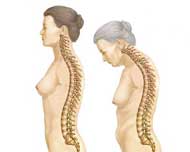 |
Osteoporosis is the most widespread degenerative disease in the developed world, afflicting 1 in 3 women and 1 in 5 men over 50. Sufferers experience decrease in bone density, which often leads
to bone fractures. In many cases, these fractures cause severe disability and even death. Depressed
individuals have a substantially lower bone density than non-depressed people and depression is associated with a markedly elevated activity of cells that breakdown bone (osteoclasts). The
association is stronger in women than men, especially young women before the end of their monthly period. This connection is especially strong in women with clinical depression diagnosed by a
psychiatrist. It was not made clear, however, which came first. Do people become depressed because they are becoming more fragile or does the cause-effect relationship go the other
way? (People with osteoporosis do sometimes look sad.) |
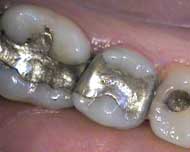 |
Tooth enamel is the hardest material in the human body because it's made almost entirely of minerals. As tough as it may be, however, enamel can be broken down by bacteria, forming
cavities and eventually destroying the tooth. That's why dentists repair cavities by filling them with a material to replace the lost enamel. The most common such
restorative is a material invented in the 19th-century known as amalgam - the classic silver-black fillings many people have. Amalgam works well because it is very durable,
easy to use, and cheap. The dark fillings are sometimes unsightly, however, and they contain mercury. Because of the mercury, amalgam has raised health and environmental
questions - though the scientific consensus is that the material poses no health hazards. Dentists would love to have a perfectly white material that mimics natural enamel for
repairing cavities in teeth, but for the most part, they still use amalgam. Other filling materials have been developed in recent years, but they often have problems with
shrinkage or durability. But a new filling made with a plastic-like material containing zirconia
nanoplatelets, when cured with an ultraviolet lamp, can harden in place without shrinking. Unfortunately, it will not be commercially available for several years. |
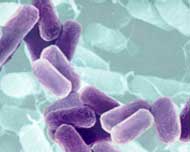 |
Using imaging mass spectrometry, researchers have developed tools that enable scientists to visualise how different populations of cells communicate. Knowing, for example, how
bacteria talk to one another may lead to new therapeutic discoveries for diseases ranging from cancer to diabetes and allergies. Microbial interactions have generally been
considered in terms of chemical activity. However, a single bacterial species is capable of producing many bioactive compounds that can alter neighbouring organisms. Chemical
"conversations" between bacteria involve many signals that function simultaneously, involving 10, 20 or even 50 molecules at one time. This tool could enable development of a bacterial
dictionary that translates these output signals. Microbes outnumber other cells in the body by a 10 to one margin. In order to communicate, bacteria secrete molecules that tell other
microbes, in effect, "I am irritated, stop growing," "I need more nutrients" or "come closer, I can supply you with nutrients." Other molecules are secreted that may turn off the body's defence
mechanisms. Understanding the means by which microorganism cells talk to one another will facilitate
therapeutic discovery of novel immune system modulators to control bacterial growth. |
 Patrick J Buchanan
Patrick J Buchanan |
"Is America at war, or not? For if we are at war, why is Khalid Sheikh Mohammed headed for trial in federal
court in the Southern District of New York? Why is he entitled to a presumption of innocence and all of the constitutional protections of a US citizen? Is it possible we have done an
injustice to this man by keeping him locked up all these years without trial? For that is what this trial implies – that he may not be guilty. And if we must prove beyond a reasonable doubt
that KSM was complicit in mass murder, by what right do we send Predators and Special Forces to kill his al-Qaida comrades wherever we find them? For none of them has been granted a fair
trial. When the Justice Department sets up a task force to wage war on a crime organisation like the Mafia or MS-13, no US official has a right to shoot Mafia or gang members on sight. No
one has a right to bomb their homes. No one has a right to regard the possible death of their wives and children in an attack as acceptable collateral damage. Yet that is what we do to
al-Qaida, to which KSM belongs. We conduct those strikes in good conscience because we believe we are at war. But if we are at war, what is KSM doing in a US court?
 | When eight German saboteurs were caught in 1942 after being put ashore by U-boat, they were tried in secret before a military commission and executed, with the approval of the Supreme
Court. What makes KSM special? |
 | How does Justice handle a defence demand for a change of venue, far from lower Manhattan, where the jury pool was most deeply traumatized by Sept. 11? Would not KSM and his co-defendants,
if a change of venue is denied, have a powerful argument for overturning any conviction on appeal? |
 | Were not KSM's Miranda rights impinged when he was not only not told he could have a lawyer on capture, but told that his family would be killed and he would be waterboarded if he refused to
talk? |
 | And if all the evidence against the 5 defendants comes from other than their own testimony under duress, do not their lawyers have a right to know when, where, how and from whom Justice got the
evidence to prosecute them? Does KSM have the right to confront all witnesses against him, even if they are al-Qaida turncoats or US spies still transmitting information to US
intelligence? |
 | What do we do if the case against KSM is thrown out because the government refuses to reveal sources or methods, or if he gets a hung jury, or is acquitted, or has his conviction overturned? |
In America, trials often become games, where the prosecution, though it has truth on its side, loses by inadvertently breaking one of the rules. The Obamaites had best pray that does not happen,
for they may be betting his presidency on the outcome of the game about to begin..."
|
The US dollar continues to decline relative to other traded currencies. Since spring, anyone could have made a double-digit rate of return betting on most any currency against the
US dollar. The International Monetary Fund (IMF) recently expressed concern that despite the dollar’s continuing slide, it might still be over-valued. The Federal Reserve’s low
interest rate policy encourages speculators to use the dollar for the "carry trade." Speculators, whether individuals or financial institutions borrow dollars at rock bottom interest
rates and use the almost-free capital to purchase higher yielding instruments in other countries. The demand for dollars to finance the carry trade keeps the dollar higher than it
would otherwise be. Last year it was the Japanese Yen that was used for the carry trade due to the practically zero Japanese interest rates. The next scare that unwinds the carry
trade will cause another big drop in financial asset values. When the carry trade next unwinds, the demand for US dollars to pay off the loans will temporarily boost the dollar - but don’t be
fooled. The large US trade and budget deficits are the dollar’s death warrant. When the dollar finally goes, so will the
government’s ability to conduct wars of aggression, underwrite Israel, finance its red ink and pay for imports. That’s when the printing press will really get going.
  
Of course the word chaos is used in rather a vague sense by a lot of writers, but in physics it means a particular phenomenon,
namely that in a nonlinear system the outcome is often indefinitely, arbitrarily sensitive to tiny changes in the initial condition.
- Murray Gell-Mann

For other updates click "Home" (for the latest) or "Next" (for older) below
|
 Animals
Animals Animation
Animation Art of Playing Cards
Art of Playing Cards Drugs
Drugs Education
Education Environment
Environment Flying
Flying History
History Humour
Humour Immigration
Immigration Info/Tech
Info/Tech Intellectual/Entertaining
Intellectual/Entertaining Lifestyles
Lifestyles Men
Men Money/Politics/Law
Money/Politics/Law New Jersey
New Jersey Odds and Oddities
Odds and Oddities Older & Under
Older & Under Photography
Photography Prisons
Prisons Relationships
Relationships Science
Science Social/Cultural
Social/Cultural Terrorism
Terrorism Wellington
Wellington Working
Working Zero Return Investment
Zero Return Investment




































